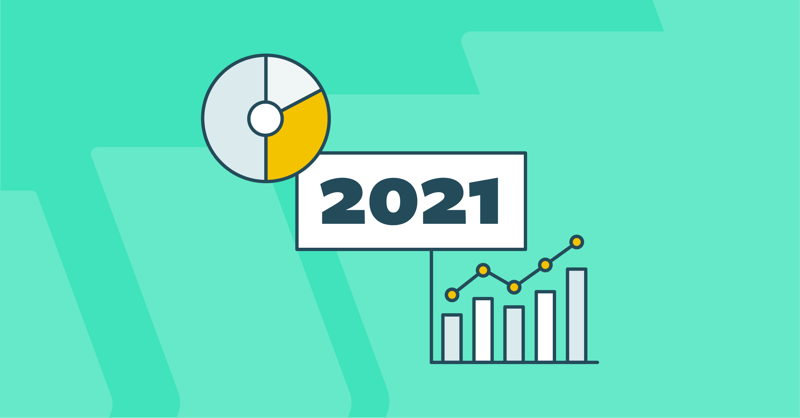Last updated: September 8, 2021

When Amazon’s been your business since 2013 like it has at SupplyKick, you become all-too-accustomed to the constant changes and challenges that emerge in the marketplace. Add working with 100+ brands across consumer categories on said marketplace, and we tend to see similar patterns across a variety of industries—what’s working, what’s not, what’s just buzz, what’s effectively driving platform sales and engagement, and what levers brands must pull in order to build a robust ecommerce plan.
The team compiled a list of the most impactful trends, tools, and predictions we’ve been following closely in 2021 for your marketing, advertising, logistics, and platform branding strategy. Here are the top six worth noting (and testing or implementing if you haven’t already)—plus a bonus 7th trend at the end of this post—for Amazon sellers and brands this year:
One of the biggest inventory management debacles of 2020 for FBA sellers will continue in 2021: stock restrictions are here to stay. Currently for any category on the marketplace, Amazon limits stock to a three-month supply, and for new products, Amazon limits it to 200 units. This is incredibly restricting for sellers of popular, seasonal, or volatile products—as these items grow in demand, there are less items actually available at Amazon warehouses to fulfill those orders, making stock outs a harsh reality for many.
Unfortunately, we’re not going to see stock limitations change much this year. As brands continue to rush to the marketplace to capitalize on soaring Amazon sales, and online shopping becomes more appealing to consumers due to the pandemic (U.S. ecommerce sales grew 32% in 2020, reaching nearly $800 billion), we’ll continue to see an increased product demand—but Amazon fulfillment space won’t increase with it anymore than it already has. This leaves FBA sellers with only a few options: stock out or raise your prices, hope to just increase sales for the units you do have in stock, or use third-party logistics.
So, how do brands and sellers improve their supply chain strategy, combat warehouse restrictions, and prevent stock outs this year? Here are a few ideas:
2021 will be the year that video becomes essential on Amazon—both organically within your product listings, Storefront, and A+ Content, as well as within your Sponsored Ads. According to marketplace data, customers who watch videos on Amazon are 3.6x more likely to purchase the product, and “shoppers spend more and visit fewer detail pages when a video is available.”
At SupplyKick, we’ve tested organic video (watch ciao! baby and Probonix) and have seen these results in action. We placed video content in photo progressions on product listings for 76 ASINs across five partner brands, resulting in an overall 29.4% conversion rate (CVR) increase from video. We found that 40% of customers watched the video in the progression, and a whopping 79% actually watched a video all the way to the end. Type of video matters, too: animated videos saw a 10.8% average CVR increase, while lifestyle/live action videos saw a 21.3% average CVR increase.
To summarize, we found that:
Now onto Sponsored Brands Video. This newer way to advertise allows brands to create Sponsored Brand videos that are keyword-targeted based on a user’s search term on Amazon. They appear to the user on mobile and desktop devices while they scroll Amazon shopping results. We’ve tested these video ads for various partners and saw significant increases in performance for revenue per click (RPC), click-through rate (CTR), and conversion rate (CVR). If you’re looking to both attract and convert more customers on the platform—and also see a great return on your investment—be sure to test and invest in video this year.
Savvy Amazon brands and sellers will realize the importance of marketplace expansion and diversification this year. For many brands, it’s no longer enough to be on just one platform— especially as online marketplaces (Amazon, Walmart, eBay, Facebook, Target, etc.) continue to compete over product assortment, pricing, shipping, subscription options, shopper insights, loyalty programs, promos, customer service, and overall ease of experience for both sellers and shoppers.
Amazon is still king of course, and we advise making sure you’re on Amazon first before exploring other marketplaces and options. But once you’re on Amazon, why not grow your revenue stream elsewhere? When you close an Amazon customer, you could also be closing a Walmart customer or an Amazon EU customer, too, with the same product assortment. There’s a huge opportunity out there to grow your volume on other marketplaces and replicate the success you’re having with Amazon elsewhere.
SupplyKick helps our partners expand their marketplace strategy to eBay, Walmart, Amazon Canada, and more. Walmart is especially appealing right now since referral fees cost less than Amazon. And since the Walmart Marketplace is essentially in the stage that Amazon was 5-10 years ago, the market is not nearly as saturated or as competitive—so if you get your products listed on there now as a Walmart Marketplace seller when market share is low, you could be giving yourself a competitive edge and setting your brand up for success and growth for years to come.
Amazon influencer marketing has been buzzed about for a few years now, and it continues to be a growing and highly successful strategy. In general, influencer marketing has taken the ecommerce world by storm—brands are set to spend up to $15B on influencer marketing by 2022.
This year, your off-platform promotion and advertising strategy (Sponsored Display, Amazon Posts, social media, influencer marketing) will be just as important as on-platform advertising. Leveraging influencers, micro-influencers, and social media campaigns to drive direct traffic and sales to your Amazon listings and Storefront can seriously boost revenue and brand presence. Plus, with recently improved Amazon Attribution capabilities giving sellers conversion tracking across social platforms—you’ll have more and more insight on customer behavior and interests to help guide future marketing, inventory, and advertising decisions on the marketplace.
It’s no secret that some Amazon categories flourished during the pandemic last year, and we’ll continue to see popularity in those categories climb. At SupplyKick, we’re seeing significant growth with partners in the Home & Kitchen; Tools & Home Improvement; Patio, Lawn, & Garden; and self-care categories like Beauty & Personal Care and Health & Household. All of these categories make sense as cooped-up consumers look to improve many aspects of their at-home situation, as well as their personal routines and lifestyle goals, right now.
A few other categories to keep on your radar this year:
Along with category trends, the pandemic has changed the way consumers shop and trust brands on Amazon. Gone are the days where a minimally optimized listing, or even simple A+ Content, will give them the information and reassurance they need to make the purchase. Amazon customers now crave authenticity and complete transparency from the brands they buy from. With millions of sellers and over 350 million products now on the marketplace, the chance is even greater for your listings to get lost and for you to lose those customers completely.
This year, you’ll see brands step up their A+ Content and Storefront game—both elements boast the most significant opportunity for brands to share their unique story, highlight key features, expand on product specifications, and display a consistent brand identity that will capture and convert new and repeat customers.
Both are essential to your 2021 marketing and advertising strategy and should be taken seriously—especially because they can have a big impact on Amazon sales. With well-executed platform branding, SupplyKick partners have seen up to a 25% conversion rate increase from A+ Content alone, and up to a 30% increase in sales per visitor on their Storefronts. Get inspiration from top brands and best practices for A+ Content and Storefront here.
Due to the Covid crisis over the past year plus, 60% of consumer interactions with companies now happen online. Ecommerce sales totaled $800 billion in 2020, and retailers are growing smarter with their 2021+ ecommerce strategies in order to capitalize on future digital growth and consumer adoption.
Once vaccinations have fully rolled out and a sense of “normalcy” returns to the world, many will be itching to escape their homes and shop for goods in person. However, we predict at some point the novelty of venturing out will wear off—and the convenience that ecommerce offers will continue. The pandemic forced once-hesitant digital shoppers to embrace ecommerce, including older generations who are much more comfortable with, entertained by, and trusting of the online process. And now that shoppers have discovered how easy it is to buy items like dog food, diapers, power tools, or their new favorite sweatpants and have them show up on their doorstep a few days later, why would they go back to brick and mortar? In-person shopping will now be reserved for experiential and emotional consumer purchases, while everyday staples and basics will mostly stay online.
Ultimately, the “behavioral trilemma” of consumer needs we’re referring to above (1. digital convenience, 2. frugality, 3. focus on self-care) in the Covid-era seems to be sticking around long after post-pandemic life settles into place. For brands and sellers everywhere, that means there’s never been a more crucial time to take action and focus on both the marketplace and ecommerce sides of your business.
Need help testing or implementing any of the trends above? Don’t have enough team members, budget, or time to devote to executing a solid Amazon strategy? Not happy with your current Amazon sales, advertising performance, or [fill in the blank here]? That’s exactly why brands team up with SupplyKick. Don’t let 2021 pass by without making ecommerce a priority this year.
Learn more about our Wholesale and Agency partnerships (or find out which option is best for you here), or reach out to get a conversation started with our team. To stay connected with the latest Amazon news, trends, results, and insights, be sure to subscribe to our newsletter.
Lorem ipsum dolor sit amet, consectetur adipiscing elit


Sign up to receive our newsletter for growth strategies, important updates, inventory and policy changes, and best practices.
These Stories on Advertising
For press inquiries, please contact Molly Horstmann, mhorstmann@supplykick.com